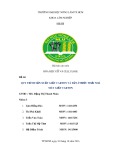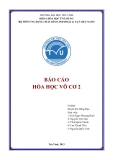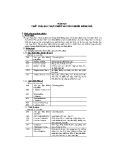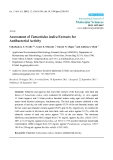Hindawi Publishing Corporation EURASIP Journal on Applied Signal Processing Volume 2006, Article ID 28636, Pages 1–11 DOI 10.1155/ASP/2006/28636
Macrocell Builder: IP-Block-Based Design Environment for High-Throughput VLSI Dedicated Digital Signal Processing Systems
Nacer-Eddine Zergainoh,1 Ludovic Tambour,1, 2, 3 Pascal Urard,2 and Ahmed Amine Jerraya1
1 TIMA Laboratory, National Polytechnique Institute of Grenoble, 46 Avenue F´elix Viallet, 38031 Grenoble Cedex 1, France 2 ST Microelectronics, 850 Rue Jean Monnet, 38926 Crolles Cedex, France 3 CIRAD, TA 40/01, avenue Agropolis Lavalette, 34398 Montpellier Cedex 5, France
Received 3 October 2004; Revised 14 April 2005; Accepted 25 May 2005
We propose an efficient IP-block-based design environment for high-throughput VLSI systems. The flow generates SystemC register-transfer-level (RTL) architecture, starting from a Matlab functional model described as a netlist of functional IP. The refinement model inserts automatically control structures to manage delays induced by the use of RTL IPs. It also inserts a control structure to coordinate the execution of parallel clocked IP. The delays may be managed by registers or by counters included in the control structure. The flow has been used successfully in three real-world DSP systems. The experimentations show that the approach can produce efficient RTL architecture and allows to save huge amount of time.
Copyright © 2006 Hindawi Publishing Corporation. All rights reserved.
1.
INTRODUCTION
functions with nonstandard algorithms [5]. This is because VLSI DSP system cannot be parameterized for global per- formance and functions; for example, necessary processing cycles cannot be adjusted for IPs blocks. The second prob- lem comes from interfacing of IPs blocks between themselves. Designers have to design IPs blocks that can communicate according to the blocks’ interface specification. When they connect two different IP blocks, they have to insert an extra interface circuitry in order to synchronize them. Area and de- lay overhead for circuitry cannot be neglected in some cases. Our goal is to find some appropriate design tactics to avoid these problems.
As the complexity of the high-throughput dedicated digi- tal signal processing (DSP) systems under hardware design increases, development efforts increase dramatically. At the same time, the market dynamics for electronic systems push for shorter and shorter development times [1]. In order to meet the design time requirements, a design methodology for VLSI dedicated DSP system that favors reuse and early error detection is essential. One idea, largely widespread and applied to design DSP systems, is to adopt a modular ap- proach based on divide-and-conquer strategy (recursive). The global complexity of the system should be divided into subsystems (i.e., elementary signal processing functions), well known and of easily accessible complexity such as fil- ter (FIR, IIR), fast Fourier transform (FFT), Viterbi decoder, and so forth. The system can be obtained by the hierarchi- cal assembly of these common functions of signal processing (also known as IP blocks). The intellectual-property- (IP)- based design is obviously an important issue for improving not only design productivity, but also design from the higher- level abstraction [2, 3].
However, designers encounter two major problems with the IP-block-based design approach [2–4]. The first problem is the difficulty in using IPs blocks for high-throughput DSP systems that require various performances (throughput) or
In this paper, we propose an efficient IP-block-based de- sign environment for high-throughput VLSI dedicated dig- ital signal processing (DSP) systems called DSP macrocells builder tool. The flow generates SystemC register-transfer- level (RTL) architecture, starting from a Matlab functional model described as a netlist of functional IP. To provide IPs with more reusability and flexibility, we use parameterized reusable DSP components at functional and RT levels. Thus, by setting the appropriate parameters, unnecessary functions and redundant interfaces are eliminated in our IP-based de- sign approach. The refinement process inserts automatically control structures to treat delays induced by the use of RTL IPs. It also inserts a control structure to coordinate the exe- cution of parallel clocked IP. The delays may be managed by
2
EURASIP Journal on Applied Signal Processing
encompass the complete problem. Some attempt to close the gap between algorithm and hardware design by basing syn- thesis tools on C/C++ description [6–11]. However, these solutions require a style of code that is very similar to RTL code and it is unattractive to algorithm designers. Commer- cial tools from design automation companies offer RTL code generation solutions from block diagrams [12]. However, these tools are targeted mostly for hardware designers and obscure the information about the algorithm and architec- ture through the code generation process.
registers or by counters included in the control structure. The main contribution of this paper is a prototype implementa- tion and experimentation of the approach. The rest of the paper is organized as follows. After investigating related work in Section 2, we introduce our methodology and discuss its merits, the important issues, and how this approach handled the IP-based design problems. Section 4 details the IP-block- based design environment for high-throughput VLSI DSP systems. Section 5 describes several experiments to analyze the efficiency of the proposed design flow and Section 6 con- cludes the paper.
2. RELATED WORK
2.1. Standard design flow for ASIC
Some have proposed using high-level system design flows, such as Ptolemy [13], and POLIS [14]. These flows em- phasize overall system cosimulation and cosynthesis for het- erogeneous systems rather than the details required in creat- ing and integrating DSP-ASIC into an existing system. There are also some works on system-level design flows targeted for DSP hardware systems [15–19]. Grape-II [15], Cham- pion [16], Logic foundry [17], and MATCH [18] follow this scheme. In Grape-II, the target architecture consists of com- mercial DSP processors, bond-out versions of core proces- sors, and FPGAs linked to form a powerful heterogeneous multiprocessor. The Logic foundry is system-level design flow for the rapid creation and integration of FPGA-based DSP by using predictable, preverified IP blocks that have standardized interfaces. The problem of this approach is that the area and delay overhead for standard interface circuitry cannot be neglected in some cases. Champion is IP-block- based design approach for data path of DSP-ASIC. The de- sign automation of data path is performed using two libraries of predesigned basic blocks (functional and cells libraries). Unfortunately, the lack of flexibility of libraries (no param- eterized blocks) limits the reuse of the IP blocks especially for high-throughput DSP systems which require various per- formances (throughput) or functions with nonstandard al- gorithms. This work was also limited to data paths without runtime control considerations. MATCH has attempted to compile high-level languages, such as Matlab, directly into hardware implementations (including code for DSP, embed- ded processors, and FPGA).
A standard design flow for hardware implementation of al- gorithms has four phases which are typically handled by four different designers. Algorithm designers conceive the chip and deliver a specification to system designers, often in the form of a floating-point simulation. The system or archi- tecture designers begin to add structure to this simulation, partitioning the design into functional units. They must also convert the data types from floating to fixed-point and ver- ify that finite word-length effects and pipeline depth do not compromise the algorithm. The hardware designers map the simulation RTL code and verify that the code matches the specified functionality and pipeline depth. Physical designers take standard-cell netlists synthesized from the RTL code and generate layout mask patterns. This flow requires three trans- lations of the design, expressing the functionality as grad- ually less sequential and more structural with requirements for reverification at each stage. Opportunities for algorithmic modifications, to reduce power and area, are often lost due to the separation of engineering decisions. Performance bot- tlenecks discovered during the physical design phase are un- known to the algorithm designer. Aggressive system require- ments may require new and unusual architectures, which can stall the flow, leading to uncontrolled looping back to earlier stages of the design process and extending the design time in- definitely. The main problem with this flow is that it attempts to avoid feedback information to algorithm designers.
However, we believe that in all above works, design methodologies tackle some issues of DSP design but they yet have to encompass the entire problem. In fact, most of the above-mentioned approaches cannot satisfy a tradeoff be- tween architecture quality, rapid algorithm/architecture ex- ploration, and fast modeling and validation.
2.3.
IP-based design issues
The flow we need would allow algorithm designers to ex- plore the design space as thoroughly as possible by creating RTL model and obtaining performance estimates. This ex- ploration should allow refinement of fixed-point types to be constrained libraries of efficient hardware blocks, and to be carried out by automated design flow. This encourages feed- back of RTL design issues to algorithm designers by allowing them to maintain ownership of the design data at all times. It also would encourage interaction with algorithm and hard- ware designers by reducing the design process to a single phase.
2.2. Current methods and flows for DSP algorithm implementation
Recent efforts have identified the gaps between algorithm, system, hardware, and physical design, but yet have to
A lot of research has been carried out on the IP-based design [2–4, 20–27]. Most of the research deals with IP- based SoC [2, 20–23]. Problems on SoC synthesis are ad- dressed in [23], where it is assumed that an external refer- ence clock is supplied and the asynchronous communication is used. However, most of on-chip buses for SoC use the syn- chronous communication. IP blocks are also exploited in the application-specific instruction-set processor (ASIP) synthe- sis for the embedded DSP software [26]. To accelerate the execution of the software, they select an optimal set of IPs
Nacer-Eddine Zergainoh et al.
3
Functional model
In Out F-IP1 F-IP2 F-IP3 System-level simulation (parameters exploration) Generic functional DSP-IP library F-IP4
Refinement (parameters extraction, FSM integration, automatic assembly) Automatic delay correction method
RTL architecture FSM
In Out RTL-IP1 RTL-IP2 RTL-IP3 Behavior difference? Generic RTL DSL-IP library RTL-IP4
Figure 1: IP-based design methodology for VLSI dedicated DSP.
RTL one, according to a set of parameters given by the designer. These are present as attributes in the functional model. The choice of IP parameter values (i.e., architec- tural parameter values such as bit width) is made by the system designer in order to satisfy a tradeoff between sig- nal quality and implementation constraints. To generate the architecture, IP parameter values are firstly extracted from a validated functional architecture model and then used to instantiate the predesigned RTL IP written in synthesizable hardware language (i.e., VHDL, SystemC). The architecture is then built by automatic assembly of predesigned RTL IPs (with the same assembly topology as the functional model). The connection between the RTL IPs is made by name. The design flow includes a unified verification platform used to verify both RTL and functional models.
and interface types for each IP. However, the interface types for IPs are restricted to coprocessor integration style. Inter- rupt/trap or shared-mapped I/O memories are often used. The software called handshaking offers flexible communica- tion between hardware and software, but it is too slow. Some researchers are trying to develop general communication in- terfaces in hardware. In the area of the application-specific integrated circuit (ASIC) design, communication between IPs is often conducted by shared registers or shared memo- ries. The typical interface configuration contains multiplexes with enable signals or address decoders. The concept of a generic virtual interface has been attracting a lot of attention as a way to increase the design reuse. General virtual inter- faces lead to designers believing that any IP could communi- cate with any other IP [27]. Some practical approaches are re- ported such as the automatic matching/generation/deletion of interface pins [3, 4, 24, 25]. General virtual interfaces are kinds of wrapper IPs, so they would have the area and delay overhead.
None of the above works solve the two above-mentioned problems for the high-throughput ASIC DSP systems. The main contribution in this paper is to provide some appropri- ate design tactics to avoid these problems.
The platform exploits directly the high-level environ- ment used for functional validation. The results of the methodology are a safety functional and RTL models of the whole DSP application. The functional model can be used as an executable reference for the next generation of design. Overall, the final architecture takes implicit advantage of the hardware designer expertise. The RTL model is suitable for logical synthesis.
3. OVERVIEW OF DESIGN METHODOLOGY
3.1. Generic DSP-IPs blocks
The IP-based design methodology is based on designer’s practice [28, 29]. The methodology, described in Figure 1, generates register-transfer-level (RTL) architecture starting from a functional model, given in Matlab. The functional modeling and RTL architecture generation are performed us- ing two libraries of predesigned DSP basic blocks (functional and RTL libraries).
In our IP-block-based design approach, the functional model is created by assembly of existing functional IP written in Matlab [30]. The refinement process keeps the same archi- tecture and replaces each functional IP by a corresponding
To provide IPs with more reusability and flexibility (prob- lem 1), we are developing parameterized reusable DSP com- ponents at functional and RTL levels called “generic F-IP” and “generic RTL IP.” We define the generic F-IP as tem- plate described in Matlab hybrid representation; many de- tails are left open, only some signals which are relevant for the quantification are implemented in quantified inte- ger. The generic F-IP blocks are stored in library. We define the generic RTL IP as a synthesizable RTL model of a basic DSP block. Each F-IP is mapped on one or more RTL IPs. A typical RTL IP is shown in Figure 2 (where the generic
4
EURASIP Journal on Applied Signal Processing
· · ·
· · ·
N = number of coefficients nbit in In Z−1 Z−1 Z−1
coeff 1 coeff 2 coeff N
+
nbit sum
Out Round Saturation
Figure 2: Generic RTL-IP description of FIR filter.
parameters are in italic). The external interface concepts (e.g., external ports-structure, functional, and timing details, generic parameters, etc.) of IPs provide how the IP block ex- changes information with its environment. The F-IP inter- face defines the component name, I/O data stream names, and generic parameters names. The external interface in- formation of RTL-IP block is described by the component definition (including component name, generic parameters names, ports names, ports directions, and ports data types). The ports can be data, clock, reset, control, and test ports. Figure 3 illustrates the analogy between F-IP and RTL-IP in- terfaces. Therefore, just by setting appropriate parameters (problem 2), unnecessary functions and redundant interfaces are eliminated in the IP-based assembly approach (no need to insert an extra interface circuitry). Furthermore, the de- signer does not have to pay attention to the communication of interface protocols.
3.2. Overview of automatic delay
technique is the area and delay overhead for each IP. How- ever, the problem occurs only in the three cases above. The second technique involves the insertion of registers between RTL IPs in order to compensate the additive delays. This technique has the advantage of being nonintrusive. However, performing the corrections manually (i.e., locating the places where the problems are, determining exactly how many reg- isters need to be inserted, and where to insert them) is a very difficult task, increasing the number of IPs. The third tech- nique involves the modification of the initial finite-state ma- chine (FSM) by generating additional signals to control the IPs. These signals are time shifted of the initial signals of the global FSM. Therefore, they are able to put back or to put for- ward the activation of the IPs. This technique adopts various stages of the second technique (i.e., locating the places where the problems are, determining exactly how many signals are needed) and requires the FSM to be modified. Modification costs more because of the complexity of the FSM (multiplies the number of control signals and increases the number of states).
correction method (ADCM)
In our IP-block-based design, we have implemented a systematic approach called “automatic delay correction method (ADCM) to solve the problem without inserting an extra interface circuitry. The ADCM implements efficiently the last two techniques (register-insertion-based and FSM modification-based). We have developed two algorithms (algorithm-1 and algorithm-2) to perform ADCM [31]. The first algorithm (algorithm-1), similar to the Bellman labeling algorithm [32], determines an optimal solution in latency; whereas the second algorithm (algorithm-2), similar to the simplex algorithm [32], determines an optimal solution in the number of inserted registers (i.e., optimizing area).
Although each functional IP and its equivalent RTL pro- duce individually the same digital values, in some cases, the register-transfer model obtained by automatic assembly from the functional model can be wrong [31]. This can oc- cur due to delays induced by implementation constraints (pipeline registers, output buffers, etc.). This behavioral fault is caused by the existence of delays in the RTL model, which cannot be found in the functional model. These delays occur when the DSP application contains parallel branches of IPs converging towards another IP, feedback loops of IPs, and/or time-depending IP. This problem is generally known as re- timing issue.
4. DSP MACROCELL BUILDER: IP-BLOCK-BASED
DESIGN ENVIRONMENT FOR VLSI DEDICATED DSP
There are three main techniques able to correct the differ- ent behavior between the two models. The first technique in- volves the insertion of synchronization protocol (e.g., hand- shake protocol) for each IP component, which indicates when the input and output data are valid. The advantage of this technique is that the delay problems are solved be- fore the assembly of RTL IPs. The main drawback of this
Our IP-block-based design environment called “DSP macro- cell builder” shown in Figure 4 consists of system-level vali- dation flow, hardware design flow (including data path and
Nacer-Eddine Zergainoh et al.
5
(cid:2)
(cid:2)
Functional Function [out1, out2] Outputs
(cid:2)
= GF IP ( In1, In2, para1, para2)
Out1 In1 Inputs Generic F-IP block
Generic parameters Out2 In2 para1, para2
(cid:2)
(cid:2)
(cid:2)
Component GRT IP generic ( RTL Generic parameters In1 para1: positive; para2: positive); Generic RTL-IP block Out1 In2 Inputs port ( in1: in std · · · ; in2: in std · · · ;
(cid:2)
Outputs para1, para2 out1: out std · · · ; out2: out std · · · ; En#1 En#2 Clock Reset
Other ports control: in std · · · ; clock: in std · · · ; reset: IN std · · · ) Systematic analogy end component;
Figure 3: F-IP interface versus RTL-IP interface.
Matlab functional
Mat2Colif
CosimX Colif functional SystemC functional architecture
(cid:3)
Prepare-1 ColifRefiner ColifLatencer
• Registers insertion-based (RegInsert) • FSM modification-based (ModFSM)
Delay correction method
Colif RTL
GenFSM Prepare-2 FSM (SystemC RTL code)
CosimX SystemC RTL netlist
Figure 4: DSP macrocell builder.
FSM), and delay correction flow for high-throughput VLSI dedicated DSP systems. The main feature of our configura- tion is that the tool flow is based on a unified design model for simulation and synthesis of system-on-chip (SoC) ar- chitectures, called “Colif ” [33]. Other tools take advantage of information from the Colif and the characteristics of the
generic IPs libraries. Initially, a designer uses the generic F-IP library to describe his functional model in Matlab [30]. The next step is to explore a pure algorithm for DSP system using Matlab environment. Then, the Mat2Colif tool transforms the Matlab description into Colif description. IP parame- ter values are extracted from a validated functional model
6
EURASIP Journal on Applied Signal Processing
M1 M2.1
M1.1
M3 M1.2 Black box
Wrapper
Module Virtual component
Task Virtual port
Configuration parameters Virtual channel
Figure 5: Colif representation.
protocol. Each Colif object has a list of local parameters, for example the kind of protocol used in a virtual channel and addresses of ports.
Colif is used as intermediate language for describing the design model through different phases of the DSP macrocell builder.
4.2. Mat2Colif
and then used by Prepare1 and CosimX tools to generate the functional architecture in SystemC [11]. The delay correction flow (including ColifRefiner, ColifLatencer, and ADCM), as will be explained later, transforms the Colif functional into a corrected Colif RTL. Architectural parameters are used to instantiate the predesigned RTL IP written in synthesizable hardware language (i.e., VHDL, SystemC). The DSP macro- cell builder includes the automatic generation of RTL Sys- temC of the final architecture (including data path and FSM). After cycle-level simulation, the generated architecture can be passed to a logic synthesis, automatic placement, and routing tools, in order to achieve a good performance circuit. The following subsections detail the several automatic
phases of the macrocell builder.
4.1. Colif (Codesign language-independent format)
The Mat2Colif is developed to transform the functional Mat- lab model into a functional description in Colif language. It consists of a lexical and syntactical analyzer applied upon the Matlab description, the functions treating the different in- put parameters of the tool, and the functions necessary for producing the correct output file. The tool needs an inter- mediate variable for integrating the inputs and the outputs. This means that it is not possible to use directly the labels of the inputs and the outputs for calling these functions. After the intermediate form is explored, the tool imports the Colif objects corresponding to functional IPs. After all the objects are correctly imported into the Colif tree structure located in memory, the tool instantiates this structure in order to obtain a suitable file for visualization. This file describes the func- tional description in Colif language.
4.3. ColifRefiner
Colif is a unified abstract model for high-level system design and refinement methodology [33]. Colif represents a system as a hierarchical network of virtual components using three basic concepts: module, port, and net. Virtual components use wrappers to separate the interface of the internal compo- nent from the interface of external nets (see Figure 5). The wrapper is the set of virtual ports of a virtual component. Virtual ports contain internal and external ports that can be different in terms of communication protocol and abstrac- tion level. Colif uses a uniform syntax to represent systems that are described at multiple abstraction levels. A virtual port can contain multiple levels of hierarchy to represent an “N : M” (N and M are natural numbers) correspondence be- tween internal and external ports. The internal ports are used to connect the internal behavior of the module to the vir- tual port. The external ports are used to connect the external communication channel to the virtual port. A virtual chan- nel groups nets that are parts of the same communication
The ColifRefiner tool transforms the Colif functional archi- tecture model into Colif RTL model. First, the Colif F-IPs are substituted by their corresponding Colif RTL IPs using the IPs libraries. Then, the module of global FSM is added and the ports-nets connections are performed. The connec- tions between IPs are made by name, meaning that ports with same role have same name in both functional and RTL mod- els. The output result of ColifRefiner is Colif RTL structure
Nacer-Eddine Zergainoh et al.
7
Module Colif: F-IP3 Module Colif: F-IP2 Out1 Module Colif: F-IP1 Data out1 s3 Data out Data in1 s1 Data in Data in In1 Data out Data in2 Data out2
s2
ColifRefiner
Module Colif: RTL-IP2 Module Colif: RTL-IP3 Module Colif: RTL-IP1 s1 s3 Out1 Data in1 Data out1 Data in Data out In1 Data in Data out Data out2 clk nrst Enable clk nrst Enable Data in2 clk nrst Enable s2
Module Colif: FSM clk Enable clk nrst nrst
Figure 6: Input and output of ColifRefiner tool.
description of the system (including data path and FSM structure). Figure 6 illustrates an example of the input and output of ColifRefiner tool.
4.4. Delay correction flow
delays. The ADCM uses two algorithms in performing the corrections needed by the differential graph of evolution in order to obtain a balanced graph. The first algorithm (algorithm-1) determines an optimal solution in latency, while the second algorithm (algorithm-2) gives an optimal solution in number of inserted registers, optimizing area. Fi- nally, the step of code generation produces a corrected RTL description of the system, inserting the right number of de- lays into the right place. The ADCM implements efficiently two alternatives to correct the RTL description of the system: one based on registers insertion while the second is based on FSM modification. According to the implementation con- straints and the target application, the designer can choose the suitable techniques to be used. In practice, the ColifLa- tencer tool inserts automatically the latency values into the Colif files (Colif RTL and functional), while the ADCM per- forms the correction.
4.5. Synthetic example
Figure 7 shows the flow of the delay correction method [31]. The inputs of this flow are Colif functional and Colif RTL descriptions of the entire system. The output of this flow is a corrected RTL-level description producing the same digital displays as the functional description. The localization and the calculation of the number of delays to be inserted require the use of an intermediate form called differential graph of evolution, highlighting the delays present in the RTL model and absent from the functional one. For that, the functional model (resp., the RTL model) is represented by a graph called functional graph of evolution (resp., RTL graph of evolution) describing its own delays. The differential graph of evolution is created by performing one by one the difference between the weight of edges of the functional graph of evolution and those of the RTL graph of evolution. This difference makes possible to see only the additive delays due to the constraints of implementation, by removing all the delays related to the functionality.
Starting from the differential graph, the ADCM deter- mines the corrections necessary to compensate the additive
In order to highlight the problem of behavior difference and its solution in a real case of IP-block-based design, we have willfully selected a synthetic example composed of two par- allel branches of block IPs tending towards the same IP (see Figure 8). One contains three FIR filters IPs and the others contain only one FIR filter. A behavior difference between
8
EURASIP Journal on Applied Signal Processing
Functional description RTL description
Compute the algorithmic delay between I/O of the IP Compute the delay between I/O of the IP
Functional graph of evolution RTL graph of evolution
path (Figure 10(a)). The other method involves modifying the initial FSM (Figure 10(b)). The initial FSM generates a control signal at each fourth clock cycle. In the case of the second correction method, the FSM has to produce a supple- mentary control signal, but delayed initially by two impulses of the first signal (8 clock cycles). Then, the filter in the sec- ond branch starts its computation after the same period as the filters of the first path. Both of the two techniques were applied upon this example. Independently of the used cor- rection method, the RTL models produce exactly the same digital values as the functional one (see Figure 11).
Delay difference
4.6. Discussion
Differential graph of evolution
ADCM
Corrected differential evolution graph
Figure 7: Delay correction flow.
We assumed the systems are mono-rates, do not include time-varying IPs, and can be built by acyclic assembly of IPs. We assumed the model is a static data flow graph (SDF graph), that is, latency and data throughput of IPs are con- stant, and this model is not a limitation of our methodol- ogy. In practice, when designing data-dependency IPs, the FIFOs with parameterized sizes are placed at the outputs of IPs; it boils down to SDF graph case. In the case of cyclic graph, heuristic algorithms that build acyclic graphs from cyclic ones need to be considered, which are outside the scope of this paper. The most high-throughput DSP systems can be supported by our methodology.
FIR1 FIR2 FIR3 FIR5 +
5. EXPERIMENTAL RESULT
×105
FIR4 Output
2 1.5 1 0.5 0 −0.5 −1 −1.5 −2 0 10 20 30 40 50 60 70 80 90 100
Matlab SystemC RTL
Figure 8: Synthetic example and problem of behavior problem be- tween functional and RTL models.
We applied our ADCM and associated IP-based design flow to synthetic example (previously presented) and three high- throughput dedicated DSP systems: digital modulation chain circuit extracted from a real design of TV digital transmis- sion satellite application, decoder based on the soft-output Viterbi algorithm (SOVA), MP3 (MPEG-1 audio layer-3) au- dio compression standard. Functional and RTL models of these three applications were built by assembling the various predesigned and prevalidated IPs. The behaviors were sub- jected to ADCM; we used two alternatives (registers insertion and FSM modification) of implementing delay correction on these circuits. The logic synthesis was performed using Syn- opsys Design Compiler [34] and the resultant circuits were mapped to AMS’s 0.35μ cell-based array library. The resul- tant gate-level circuits were compared with respect to the following metrics: area and performance. The area and clock period are obtained after performing synthesis and technol- ogy mapping. The performance, that is, execution time is the product of clock period and number of clock cycles (RTL simulation).
Table 1 presents the number of registers inserted af- ter the behaviors which were performed by ADCM (i.e., algorithm-1 and algorithm-2). Save for the synthetic exam- ple, algorithm-2 improves significantly the solutions found by algorithm-1. The average registers improvement is 50% (the averages were calculated based on comparing the sum of the values in algorithm-1 and algorithm-2 columns).
the RTL and functional model has been detected by our ADCM as well as during both functional and cycle accurate simulations (both digital data curves in Figure 6 are differ- ent). The problem is due to an output register present in each RTL FIR filter and absent in functional filters. This register induces an additional delay in the RTL model. The differen- tial graph of evolution is shown in Figure 9. The first path has three additional delays, whereas the second path has one additional delay. It was necessary to add two delays in the sec- ond path in order to balance the differential graph. This de- lay correction was translated in two ways on the RTL model. The first one consists of inserting two registers in the second
In Tables 2 and 3, we present, respectively, execution time and area results. The results are obtained according to the fol- lowing three cases: designs without ADCM (second column),
Nacer-Eddine Zergainoh et al.
9
0 1 1 1 IN1 FIR1 FIR2 FIR3
Correction 0 0 + FIR5 Out 1 +2 0 IN2 FIR4
Figure 9: Balanced differential graph of evolution.
C1 C1 C1
Table 1: Registers insertion performed by ADCM algorithms.
C1 FSM FIR1 C1 + FIR5
Registers inserted no.
C1
System
FIR4 Clk FIR3 C1 Z−1 FIR2 C1 Z−1 C1 Correction (a)
Algorithm-1 2 15 9 12
Algorithm-2 2 7 5 5
Synthetic example Modulation chain SOVA MP3 decoder
C1 C1 FSM C1 C1 C2 C1 FIR1 FIR2 FIR3 FIR5 + C2 FIR4 Clk C1 C2 Correction (b)
Figure 10: Two ways to correct the behavior in RTL model: (a) delay correction by registers insertion and (b) delay correction by modi- fying FSM.
×105
Output 8 6 4 2
for circuitry cannot be neglected in the first case (second column). Regarding both alternatives of ADCM (registers insertion versus FSM modification), the two corrections are equivalent in terms of performances (third and fourth columns in Table 2). With regard to area (third and fourth columns in Table 3), the two corrections give the slightly dif- ferent results. We note that the difference is the area no more than 4% for the cases studied. This difference is due to the way in which the N delays correction are distributed on the balanced differential graph. The N delays correction on dif- ferential graph correspond to M (1 ≤ M ≤ N, M depends on the distribution of delays correction on the differential graph) supplementary control signals in ADCM by FSM modification, whereas they always correspond to N registers in ADCM by registers insertion. The choice of a method is closely related to the application and must be done after ap- plying the two methods, and analyzing the area results.
0 −2 −4 −6 −8
6. SUMMARY AND CONCLUSIONS
0 10 20 30 40 50 60 70 80 90 100
Matlab RTL
Figure 11: Output signals of functional and corrected RTL models.
designs with ADCM by registers insertion (third column), and ADCM by FSM modification (fourth column). In the first case (second column), the interfacing of IPs blocks was performed by inserting an extra interface circuitry (i.e., handshake protocol), in order to synchronize them.
In this paper, we proposed an efficient IP-block-based design environment for high-throughput VLSI Systems. The flow generates SystemC RTL architecture, starting from Matlab- based functional model of digital system. To provide IPs with more reusability and flexibility, we are developing parame- terized reusable DSP components at functional and register- transfer level called “generic F-IP” and “generic RTL-IP.” Thus, by setting the appropriate parameters, unnecessary functions and redundant interfaces are eliminated in the IP- based design approach. Although each functional IP and its equivalent RTL produce the same digital displays, in some cases, the register-transfer model obtained by automatic as- sembly from the functional model can be wrong. We have also proposed an approach called automatic delay correction method to solve this problem without the insertion of an ex- tra interface circuitry. The approach corrects the behavior of
Tables 2 and 3 indicate that our ADCM results in sig- nificant improvements of performance and area, the aver- age performance improvement is 15.67%, whereas the av- erage area improvement is 10.7%. Area and delay overhead
10
EURASIP Journal on Applied Signal Processing
Table 2: Performance results: registers versus FSM modification.
Execution time (ns)
System
Without ADCM 4567870 2297500 68266
ADCM by registers insertion 3859850 1929902 58026
ADCM by FSM modification 3859854 1929907 58027
Modulator MP3 decoder SOVA∗
∗Time required to decode a single 1024-bit block of information using 4-stage iterative decoding.




































